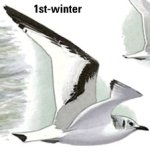No; kittiwakes retain their juvenile plumage until spring. They do not moult into a 1st-winter plumage.
The term 'first winter' should refer to plumage, not time of year. It is used to indicate that the bird is no longer juvenile.
A bird can be in 1st-w plumage already in August, i.e. summer.
Lots of passerines, e.g., have moulted their juvenile plumage by then, as have many terns, gulls etc.
I know many birders think like "It's a first-year bird and it is now winter so I am calling it a first-winter bird" but, if you think about it, that idea is flawed.
A first-winter Sabine's gull or Lesser black-backed gull that crosses the equator into the southern hemisphere would then suddenly be a first-summer bird according to that logic. Also, there are many raptors, albatrosses and other large birds that retain their juvenile plumage for almost a year or longer. Why would you make a distinction between juvenile and 1st-winter in such cases, as the plumage looks exactly the same?
And if it is really time of year that defines a bird's age, do you also talk about "1st-spring" or "1st-autumn" Common Buzzard and such?
See also the terminology in the Introduction (p. 9) in the Collin's Guide:
"1st-winter - age category usually referring to the plumage following that of the juvenile, usually gained through a partial (in some species) complete moult in late summer/autumn of 1st calendar-year, and worn until the next moult in the spring of 2nd calendar-year."








